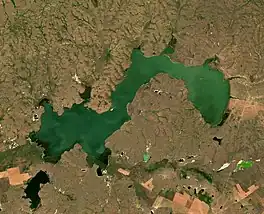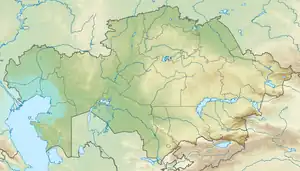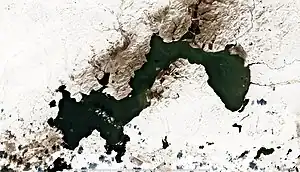| Karasor | |
|---|---|
| Қарасор | |
 Sentinel-2 image of the lake in June 2021 | |
 Karasor | |
| Location | Kazakh Uplands |
| Coordinates | 49°53′N 75°23′E / 49.883°N 75.383°E |
| Type | endorheic |
| Primary inflows | Taldy, Karasu, Yesenaman, Barak and Kemer |
| Primary outflows | none |
| Catchment area | 8,750 square kilometers (3,380 sq mi) |
| Basin countries | Kazakhstan |
| Max. length | 43 kilometers (27 mi) |
| Max. width | 7.3 kilometers (4.5 mi) |
| Surface area | 154 square kilometers (59 sq mi) |
| Average depth | 2.5 meters (8 ft 2 in) |
| Max. depth | 5 meters (16 ft) |
| Water volume | 160,000,000 cubic meters (5.7×109 cu ft) |
| Residence time | UTC+6 |
| Shore length1 | 103 kilometers (64 mi) |
| Surface elevation | 622 meters (2,041 ft) |
| Islands | Zhumyrtkaly and Araltabe |
| 1 Shore length is not a well-defined measure. | |
Karasor (Kazakh: Қарасор; Russian: Карасор),[1][2] is a salt lake in Karkaraly District, Karaganda Region, Kazakhstan.[3][4]
Karasor is the largest lake in Karaganda Region. It is located 45 kilometers (28 mi) to the north of Karkaraly city. The nearest inhabited pace is Koyandy village, close to the eastern lakeshore.[5] The mud at the bottom of the lake has medicinal properties.[6]
Geography
Karasor is an endorheic lake in the central Kazakh Uplands. It stretches from east to west to the north of the Karkaraly Range and to the south of the Ayr Mountains. It is the largest of the lakes at the bottom of a vast depression without drainage. Smaller lake Katynkol is located to the SW of the southern end, Saumalkol to the west, and Balyktykol 20 kilometers (12 mi) to the east. The shape of Karasor is sinuous, narrower in its central section. The bottom of the lake is mostly silt, with a smell of hydrogen sulfide. The lakeshores are complex, some stretches are clayey or pebbly, low and gently sloping, but in certain areas they are rocky, with cliffs reaching a height of 25 meters (82 ft). There are two little islands on the lake, Zhumyrtkaly and Araltabe.[1]
Fourteen small rivers flow into Karasor, including the 159 kilometers (99 mi) long Taldy, as well as the Karkaralinka, Karsakpai, Karasu, Yesenaman, Barak and Kemer. All of them dry up in the summer. On average, the highest water level of the lake is in April and the lowest in November. Karasor usually freezes in November and thaws in late April or early May.[5] During periods of drought the shallow eastern part of the lake may dry up, turning into a salt pan.[1]
 Sentinel-2 image of the lake in October. |
Flora and fauna
The land in the 8,750 square kilometers (3,380 sq mi) basin around Karasor includes plowed agricultural fields with clay and loam soils. The vegetation of the lakeshore zone includes spear grass, wormwood, Siberian peashrub and fescue.[6][7]
Every year at Karasor there is a large concentration of about 5,000 common shelducks during their moulting season.[8]
See also
References
- 1 2 3 Карасор; Great Soviet Encyclopedia in 30 vols. — Ch. ed. A.M. Prokhorov. - 3rd ed. - M. Soviet Encyclopedia, 1969-1978. (in Russian)
- ↑ Площадь озер Казахстана (Таблица)
- ↑ "M-43 Topographic Chart (in Russian)". Retrieved 18 August 2022.
- ↑ Lakes in the Central Kazakhstan
- 1 2 Google Earth
- 1 2 Jilili Abuduwaili, Gulnura Issanova, Galymzhan Saparov, Hydrology and Limnology of Central Asia. pp. 177-181
- ↑ News of the National Academy of Sciences of the Republic of Kazakhstan
- ↑ Karasor Lake - BirdLife Data Zone
External links
 Media related to Karasor at Wikimedia Commons
Media related to Karasor at Wikimedia Commons- Озера и реки Казахстана (in Russian)